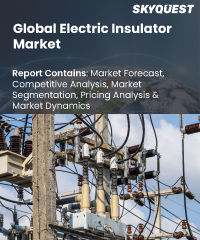
Report ID: SQMIG20D2142

Report ID:
SQMIG20D2142 |
Region:
Global |
Published Date: March, 2024
Pages:
202
|
Tables:
91 |
Figures:
76
Electric Insulator Market size was valued at USD 12.68 billion in 2022 and is poised to grow from USD 13.39 billion in 2023 to USD 20.71 billion by 2031, growing at a CAGR of 5.60% during the forecast period (2024-2031).
Global Electric Insulator Market is a thriving sector that plays a crucial role in ensuring the safe and reliable transmission and distribution of electricity. The increasing global demand for electricity, driven by population growth, urbanization, and industrialization, creates a need for expanding and upgrading power infrastructure. This, in turn, boosts the demand for electric insulators. Also, the growing focus on renewable energy sources, such as wind and solar power, requires the development of new transmission and distribution systems, further driving the demand for insulators. Additionally, the rising investments in grid modernization, smart grids, and electrification projects worldwide contribute to market growth.
Factors such as economic downturns, budget constraints, and fluctuations in raw material prices can impact market growth. Additionally, the availability of low-cost alternatives and counterfeit products may pose challenges to established market players. Moreover, the complexity and high cost of installing insulators in challenging terrains or remote areas can hinder market expansion in certain regions. Key trends in the electric insulator market include the development of lightweight and compact insulator designs, aimed at improving installation efficiency and reducing maintenance requirements. The integration of advanced materials, such as composite insulators, is gaining traction due to their superior performance, durability, and resistance to environmental factors.
Furthermore, the market is witnessing a shift towards digitalization and IoT-enabled insulator monitoring systems, which enhance the reliability and predictive maintenance capabilities of power networks. Amidst these challenges and trends, several opportunities exist in the electric insulator market. The increasing investments in the expansion and upgrade of power transmission and distribution infrastructure across emerging economies present significant growth prospects. Additionally, the integration of insulators in high-voltage direct current (HVDC) transmission systems for long-distance power transmission offers new avenues for market expansion. Moreover, the focus on renewable energy integration and the electrification of transportation presents opportunities for innovative insulator solutions to meet the evolving needs of the industry.
US Electric Insulator Market is poised to grow at sustainable CAGR for the next forecast year.
Our industry expert will work with you to provide you with customized data in a short amount of time.
REQUEST FREE CUSTOMIZATIONWant to customize this report? This report can be personalized according to your needs. Our analysts and industry experts will work directly with you to understand your requirements and provide you with customized data in a short amount of time. We offer $1000 worth of FREE customization at the time of purchase.

Report ID: SQMIG20D2142